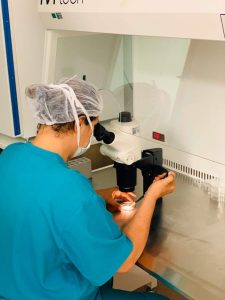What is embryo freezing ?
It is the process of storing embryos created with in vitro fertilisation treatment with a particular method for use at a later date. In most in vitro fertilisation treatments, the patient has a good-quality embryo left over, and these embryos can be stored. In this way, when the patient needs another embryo transfer, the entire in vitro fertilisation treatment is not done from the beginning, and only the endometrium, which is the inner wall of the uterus, is prepared, and a complete treatment chance is obtained by transferring frozen embryos.
Who can apply embryo freezing ?
- Good quality embryos remain after embryo transfer
- In exceptional cases where embryo transfer during IVF treatment will adversely affect the patient's health (such as ovarian hyperstimulation syndrome, characterised by excessive stimulation of the ovaries)
- In special cases that may negatively affect the success of IVF treatment (such as thin endometrium, polyp-like conditions, ovarian cyst formation)
- When embryo transfer is planned to be performed after resting the uterus in the following month
- In addition to IVF treatment, genetic PGD applications that will result in long-term
- Non-treatment conditions that require postponement of embryo transfer (such as emergencies or family reasons)
- If there is a family history of early menopause or low ovarian reserve
- In order to create an embryo pool in patients with low reserve where a small number of embryos can be created
- To obtain embryo guarantee before treatments that may affect ovarian reserve (such as surgery, chemotherapy or radiotherapy targeting the ovaries)
- The couple does not plan to have children at the moment and wants to have children in the future
Is embryo freezing safe ?
When embryo freezing is done using the proper method and high technology, embryos can be frozen and thawed with almost 100% success. The laboratory quality of a centre can be evaluated by the pregnancy rates obtained with frozen embryos. For this reason, performing IVF treatment in laboratories in a fully equipped hospital significantly increases pregnancy success. In our modern IVF laboratory in our hospital, the viability rate after the embryo freezing and thawing process is 99-100%. Since the embryos are kept completely dormant while being stored frozen, they are practically never damaged and are no different from fresh embryos when used later.
How long can an embryo be frozen ?
Since frozen embryos are frozen with patient consent, they can continue to be frozen in practice if the couple or patient's consent continues. Our centre has no legal upper limit period; freezing can continue as long as our patients meet the annual freezing continuation conditions.
If any patient from the couple withdraws consent for embryos made with the couple's eggs and sperm, or if the patient loses his/her mental health or dies, the embryos will be destroyed.
How is frozen embryo transfer done ?
Embryos that are frozen while suitable for transfer are subjected to a special thawing process. Frozen embryo transfer is a straightforward procedure, just like fresh embryo transfer, if there is no problem with the cervix or the shape of the uterus, and it does not require anaesthesia unless there is a particular reason. The embryo transfer procedure is a very special moment, and female patients need to be involved in this procedure in terms of motivation. The embryo or embryos are transferred to the most suitable place in the uterus through a thin catheter passed through the cervix by our infertility specialist doctor. Embryo transfer can be done between the first and sixth day of embryo transfer, but the most common frozen embryo development days are the third and fifth days. In our centre, all decisions regarding embryos are made together.
Another issue is the embryo number that will be transferred. As the number of embryos transferred increases, the chance of pregnancy in IVF increases. Therefore, patients can choose reliable countries where they can transfer up to 3 embryos. The laws in Cyprus legally allow the transfer of 1 to 3 embryos, depending on the patient's condition. On the other hand, as the number of embryos transferred increases, the possibility of multiple pregnancies (especially twin pregnancies) increases. Since multiple pregnancies are more difficult to follow and riskier, the number and development quality of the embryos, the clinical condition of the patient, and the patient's expectations are variables. The doctor and the patient, aware of these variables, meet, and the most appropriate management for the patient can be determined following this meeting.
On the day of embryo transfer, the embryos decided to be transferred to our patient whose endometrium, the inner wall of the uterus, has been prepared for pregnancy in advance are thawed and placed in embryo glue (i.e. embryo adhesive) fluid at our centre without any additional charge. In this way, the chances of attachment after the transfer are increased, and our patients' chances of pregnancy are increased. An assisted hatching procedure is also applied to suitable embryos free of charge just before the transfer. In this procedure, the embryo membrane is thinned from a certain point with a special beam, increasing the chance of the embryo's implantation.
What is the price of embryo freezing ?
Due to the law, we cannot share information on embryo freezing prices on our website. You can contact us for detailed information.



